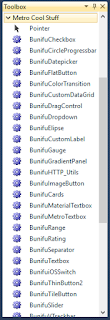The new Modern UI apps are pretty fascinating , aren't they? Building these apps with older versions of Visual Studio like the 2010 edition is pretty cumbersome. While the newer 2015 and 2017 editions of Visual Studio come with Expression Blend, which helps to build those.
But what if you want to build them with yuor old IDE itself, in the VS 2010?
Yes, you can. You need the Bunifu Framework. It's availabel as a trial for 7 days or you can buy rhe oaid version.
let me show you how it works
You can download it from its official site.
After installing the app, provide your email and your trial period is good to go for 7 days.
Then open Visual Studio. Under toolbox add a new tab with whatever name you would like to give. Then right click on it and hit Choose items.
In the dialogue box shown, choose the .dll file by clicking the Browse button,
Finally click open and go further. After all the controls being added you can use them to create your Modern UI apps hands down.
You can just drag and drop them as you could do with your normal toolbox controls.
Here's a sample:
And remember it works only for WinForms not WPF or anything else.
But what if you want to build them with yuor old IDE itself, in the VS 2010?
Yes, you can. You need the Bunifu Framework. It's availabel as a trial for 7 days or you can buy rhe oaid version.
let me show you how it works
You can download it from its official site.
After installing the app, provide your email and your trial period is good to go for 7 days.
Then open Visual Studio. Under toolbox add a new tab with whatever name you would like to give. Then right click on it and hit Choose items.
In the dialogue box shown, choose the .dll file by clicking the Browse button,
Finally click open and go further. After all the controls being added you can use them to create your Modern UI apps hands down.
You can just drag and drop them as you could do with your normal toolbox controls.
Here's a sample:
And remember it works only for WinForms not WPF or anything else.





Comments
Post a Comment